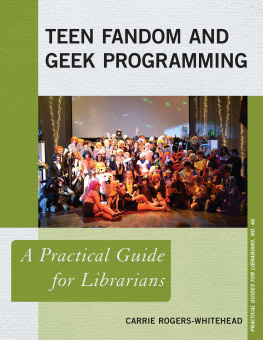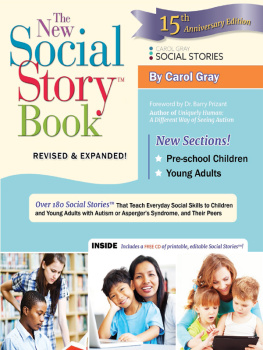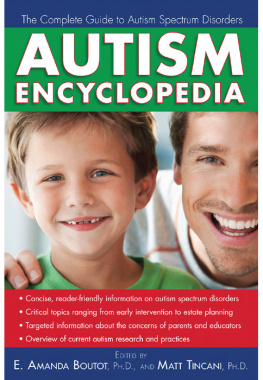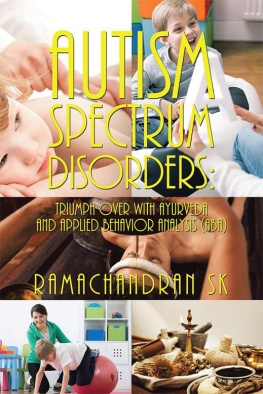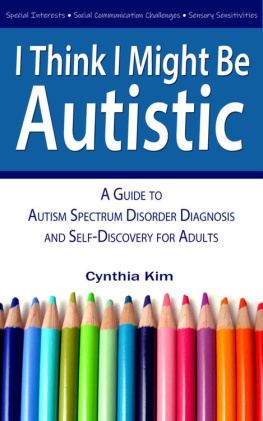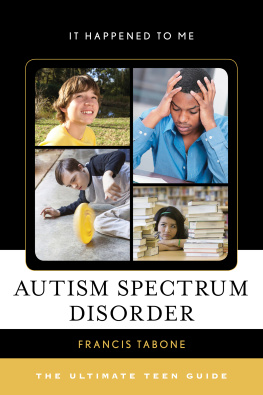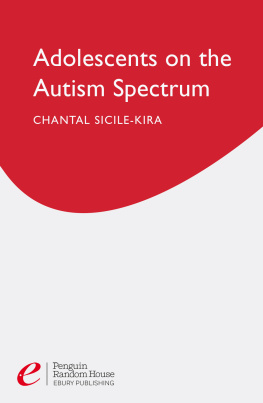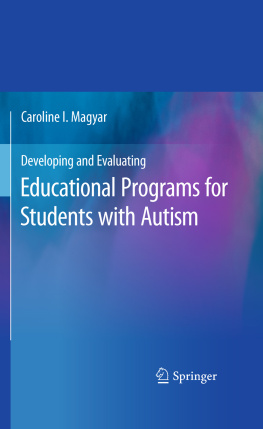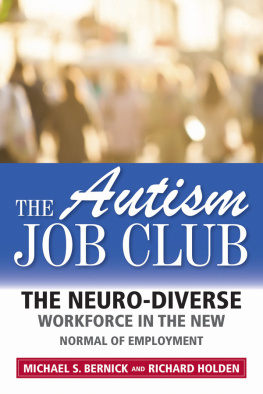SERVING TEENS AND ADULTS ON THE AUTISM SPECTRUM
A Guide for Libraries
Carrie Rogers-Whitehead

Copyright 2020 by Carrie Rogers-Whitehead
All rights reserved. No part of this publication may be reproduced, stored in a retrieval system, or transmitted, in any form or by any means, electronic, mechanical, photocopying, recording, or otherwise, except for the inclusion of brief quotations in a review, without prior permission in writing from the publisher.
Library of Congress Cataloging-in-Publication Data
Names: Rogers-Whitehead, Carrie, 1983 author.
Title: Serving teens and adults on the autism spectrum : a guide for libraries / Carrie Rogers-Whitehead.
Description: Santa Barbara, California : Libraries Unlimited, [2020] | Includes bibliographical references and index.
Identifiers: LCCN 2020011233 (print) | LCCN 2020011234 (ebook) | ISBN 9781440874819 (paperback ; acid-free paper) | ISBN 9781440874826 (ebook)
Subjects: LCSH: Libraries and the developmentally disabled. | Autism spectrum disorders.
Classification: LCC Z711.92.D48 R64 2020 (print) | LCC Z711.92.D48 (ebook) | DDC 027.6/63dc23
LC record available at https://lccn.loc.gov/2020011233
LC ebook record available at https://lccn.loc.gov/2020011234
ISBN:978-1-4408-7481-9 (paperback)
978-1-4408-7482-6 (ebook)
242322212012345
This book is also available as an eBook.
Libraries Unlimited
An Imprint of ABC-CLIO, LLC
ABC-CLIO, LLC
147 Castilian Drive
Santa Barbara, California 93117
www.abc-clio.com
This book is printed on acid-free paper 
Manufactured in the United States of America
For Miss Chris
aka Chris Kamlowsky
and her tireless service for those with autism, and being a caring friend.
Contents
Preface
This book uses people-first language (also known as person-first language) when speaking about those with autism. People-first language (PFL) puts the individual over their diagnosis. Its a requirement in the American Medical Associations manual of style, and is used in U.S. government institutions on the federal level, such as with the Centers for Disease Control and Prevention.
However, there is another style of language: identity first. Heres an example of how the two languages are used:
People-first language: Person with autism
Identity-first language: Autistic person
The reader should know that there is controversy between the two styles of languages. An autistic person I interviewed for this book, J, has this to say on the subject:
When people use person-first language, they say, You are not your diagnosis! You are so much more than that! Dont let it define you! But it does define me. Autism is not an accessory I carry around with me, separate from myself. In fact, if you were to try to separate me from it, I would no longer recognize myself. My friends and family would no longer recognize me. I would literally not be the same person.
It affects how I experience the world around me (e.g., the way I hear sounds), the way I navigate through the world, the way I move my body, the way I form and express my thoughts, the way I interpret whats happening around me. It directs my hopes, dreams, fears, and passions. Try taking those things away from yourself, and tell me if youd still be you.
This is important because when people use PFL, they are implying that autism is a negative thing that I would want to be detached from, to not be defined by. You have no problem calling me right-handed, even though those aspects dont define me in the slightest. Youd sound silly calling me an individual with right-handedness. Because theres no stigma about handedness (at least, not anymore!), so you dont feel the need to tiptoe around it or artificially separate me from it.
When I interviewed those with autism for this book, I asked them how they would like to be referred. Some preferred people-first language, others identity-first. If a library staff member is unsure what style to use, just ask the person.
Autism is a spectrum of many abilities, opinions, identities, experiences, and desires. It is difficult to speak for everyone in the spectrum. When writing this book, I kept in mind my audience, librarians. From my experience as a librarian, I would have wanted a book with more suggestions and advice for those with autism that perhaps struggle more with their diagnosis. This book is written in that lens. It focuses more on services and adaptations for those with autism who may struggle. This group on the spectrum may not be able to live unassisted, might be nonverbal, and have multiple conditions that affect their day-to-day life. However, the reader should note that not all those with autism are in that situation.
I want the reader to know that I am not autistic and do not speak for that community. I strove in writing this book to feature those voices, the ones who are #actuallyautistic, and their thoughts and stories are throughout the book. If you are working to improve your library services to those with autism, I encourage you to reach out to them.
This book, and the library programs Ive done throughout the years, would not exist without the Utah autism community. They guided, advised, introduced, advocated, and helped me. I am in debt to their assistance, and I hope this book can help me pay it forward.
Introduction
Over half a million individuals with autism will become adults by 2027 according to the National Autism Indicators Report (U.S. Department of Health and Human Services, 2017b). More adults are being diagnosed with autism, and those diagnosed as children are growing up. Although teens and adults do not develop autism, diagnostic tools have improved since they were children, which may make their diagnosis come later in life. Children are screened and diagnosed at earlier ages now. Clinicians also have a better understanding of the variability of symptoms and behaviors of autism. Autism is a spectrum and can manifest in widely different ways depending on the individual.
A study from the American Journal of Medical Genetics in 2015 found a 331 percent increase in autism diagnosis from 2000 to 2010 from the recategorization of autism diagnosis, and how autism can be marked through other co-occurring illnesses (Polyak et al., 2015). Most of those individuals who had their disorders recategorized by autism were older children, who then subsequently would not have the same level of early intervention as those younger. Early intervention is important for those with autism. It can improve IQ and in some cases can assist children to join mainstream school classes earlier. Treatments can start as early as eighteen months for infants who have a diagnosis (Eldevik et al., 2009).
There is no outbreak of autism, just better awareness and understanding. This leads to a large cohort of older children diagnosed a decade or less ago, now approaching or already reaching adulthood. Service providers are not prepared for this oncoming demographic wave. This growing group of adults will need inclusive housing, medical care, jobs, education, legal assistance, recreational activities, and much more. We also dont fully understand how to integrate this group into employment, schooling, and the larger society. Only about 2 percent of federal and private funding goes into researching how teens with autism can better transition into healthy, functioning adults, according to the U.S. Department of Health and Human Services (U.S. Department of Health and Human Services, 2017b).
Teens and adults with autism spectrum disorder (ASD) have a unique set of needs that many service providers are not trained for. A general practitioner may know how to diagnosis an illness, but not how that illness can interact with ASD. A lawyer may understand the law, but not how that law affects someone who cannot care for themselves. A librarian may know how to create teen programs, but not how to make those programs inclusive for individuals on the spectrum.
Next page


